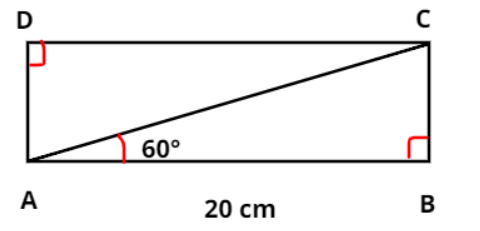
In a rectangle ABCD, AB = 20 cm, $\angle BAC = {60^ \circ }$ calculate side BC and diagonals AC, BD.


Answer
569.4k+ views
Hint: In this question we will be using some basic trigonometric formulas like $\tan \theta = \dfrac{{Perpendicular}}{{Base}}$ and ${\text{cos}}\theta = \dfrac{{Base}}{{Hypotenuse}}$also some basic properties of rectangles which can be used to approach the solution.
Complete step-by-step answer:
Given, ABCD is a rectangle, AB = 20 cm, $\angle BAC = {60^ \circ }$
From the figure, we can clearly see that $\Delta ABC$ is a right-angled triangle at vertex B
As in a right-angled triangle we know that the side opposite to right angle AC is hypotenuse, side opposite to the considered angle ($\angle BAC$) BC is perpendicular and the remaining side is base
Also, $\tan \theta = \dfrac{{Perpendicular}}{{Base}}$and ${\text{cos}}\theta = \dfrac{{Base}}{{Hypotenuse}}$
In $\Delta ABC$ from the figure, we can write
$\tan \left( {\angle BAC} \right) = \dfrac{{BC}}{{AB}} = \dfrac{{BC}}{{20}}$
$ \Rightarrow \dfrac{{BC}}{{20}} = \tan {60^ \circ }$
$ \Rightarrow BC = 20\tan {60^ \circ }$
Since, $\tan {60^ \circ } = \sqrt 3 $
$ \Rightarrow BC = 20\sqrt 3 cm$
Length of side BC is $20\sqrt 3 cm$
Again from $\Delta ABC$, we can write
$\cos \left( {\angle BAC} \right) = \dfrac{{AB}}{{AC}} = \dfrac{{20}}{{AC}}$
$ \Rightarrow \dfrac{{20}}{{AC}} = \cos {60^ \circ }$
$ \Rightarrow AC = \dfrac{{20}}{{\cos {{60}^ \circ }}}$
Since, $\cos {60^ \circ } = \dfrac{1}{2}$
$ \Rightarrow {\text{AC}} = \dfrac{{20 \times 2}}{1} = 40{\text{ cm}}$
Length of diagonal AC is 40 cm
Also, according to the properties of a rectangle we know that the diagonals of a rectangle are equal in length
Therefore, AC = BD = 40 cm
Hence, the length of both the diagonals AC and BD is 40 cm.
Note: These types of problems are simply solved with the help of the figure which can be drawn by considering the aspects of the problem. After that some basic geometry is applied to these problems and solved by simple trigonometric formulas.
Complete step-by-step answer:
Given, ABCD is a rectangle, AB = 20 cm, $\angle BAC = {60^ \circ }$
From the figure, we can clearly see that $\Delta ABC$ is a right-angled triangle at vertex B
As in a right-angled triangle we know that the side opposite to right angle AC is hypotenuse, side opposite to the considered angle ($\angle BAC$) BC is perpendicular and the remaining side is base
Also, $\tan \theta = \dfrac{{Perpendicular}}{{Base}}$and ${\text{cos}}\theta = \dfrac{{Base}}{{Hypotenuse}}$
In $\Delta ABC$ from the figure, we can write
$\tan \left( {\angle BAC} \right) = \dfrac{{BC}}{{AB}} = \dfrac{{BC}}{{20}}$
$ \Rightarrow \dfrac{{BC}}{{20}} = \tan {60^ \circ }$
$ \Rightarrow BC = 20\tan {60^ \circ }$
Since, $\tan {60^ \circ } = \sqrt 3 $
$ \Rightarrow BC = 20\sqrt 3 cm$
Length of side BC is $20\sqrt 3 cm$
Again from $\Delta ABC$, we can write
$\cos \left( {\angle BAC} \right) = \dfrac{{AB}}{{AC}} = \dfrac{{20}}{{AC}}$
$ \Rightarrow \dfrac{{20}}{{AC}} = \cos {60^ \circ }$
$ \Rightarrow AC = \dfrac{{20}}{{\cos {{60}^ \circ }}}$
Since, $\cos {60^ \circ } = \dfrac{1}{2}$
$ \Rightarrow {\text{AC}} = \dfrac{{20 \times 2}}{1} = 40{\text{ cm}}$
Length of diagonal AC is 40 cm
Also, according to the properties of a rectangle we know that the diagonals of a rectangle are equal in length
Therefore, AC = BD = 40 cm
Hence, the length of both the diagonals AC and BD is 40 cm.
Note: These types of problems are simply solved with the help of the figure which can be drawn by considering the aspects of the problem. After that some basic geometry is applied to these problems and solved by simple trigonometric formulas.
Recently Updated Pages
Master Class 11 Economics: Engaging Questions & Answers for Success

Master Class 11 English: Engaging Questions & Answers for Success

Master Class 11 Social Science: Engaging Questions & Answers for Success

Master Class 11 Biology: Engaging Questions & Answers for Success

Class 11 Question and Answer - Your Ultimate Solutions Guide

Master Class 11 Business Studies: Engaging Questions & Answers for Success

Trending doubts
10 examples of friction in our daily life

One Metric ton is equal to kg A 10000 B 1000 C 100 class 11 physics CBSE

Difference Between Prokaryotic Cells and Eukaryotic Cells

1 Quintal is equal to a 110 kg b 10 kg c 100kg d 1000 class 11 physics CBSE

Explain zero factorial class 11 maths CBSE

What is a periderm How does periderm formation take class 11 biology CBSE




